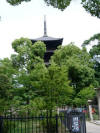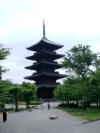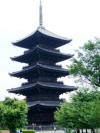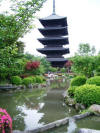|


























| |
The Tōji Temple brochure provides the
following information:
In the thirteenth year of Enryaku
(794), the Emperor Kammu transferred the capital of Japan from Nara to Kyōto and
built, after the model of Changan, the then capital of China, two huge guardian
temples on the east and west sides of the Rajyō-mon, which was the south gateway
to Kyōto. They are Tōji (East Temple) and Saiji
(West Temple).
About thirty years later, the Emperor
Saga honored Kūkai (774~835, founder of Shingon Buddhism) with Tōji
Temple and gave it the official name Kyō-ō-gokokuji, which means “the temple
that guards the capital and the land by virtue of Ninnō-gokoku-kyō (the main
sutra of the Shingon sect).” Kūkai made Tōji the
central seminary of esoteric Buddhism and added various other buildings to it.
It retains the original layout and architectural style and is known as a
treasure house of esoteric Buddhist art, due to its large number of cultural
assets brought back from China, such as old Buddhist statues, carvings,
magnificent paintings, artistic handicrafts, etc.
A sign on the grounds of the temple
records the temple’s designation as a UNESCO World Heritage site:
-
In conformity with the Convention
Concerning the Protection of the World Cultural and Natural Heritage adopted
by the United Nations Educational, Scientific and Cultural Organization
(UNESCO), Kyo-o-Gokokuji Temple is inscribed on the World Heritage List as a
Historic Monument of Ancient Kyoto. It is thus internationally recognized as
a place of exceptional and universal value: a cultural heritage site worthy
of preservation for the benefit of all mankind.
-
Kyo-o Gokokuji Temple, better known
as Toji Temple, was one of the state-sponsored temples constructed for the
pacification and protection of the nation in the course of establishing the
Heian-kyo (Kyoto) capital. In 823, the reigning emperor conferred the
abbotship of the temple on the great Buddhist teacher Kukai, who made it a
seminary for the practice of Shingon-sect esoteric Buddhism, as a result of
which the temple compound took on a genuinely monastic appearance.
-
Destroyed by fire time and again
during civil wars and insurrections, Kyo-o-Gokokuji Temple was rebuilt on
each occasion by the government of the time, under whose patronage it
remained through the centuries. The temple buildings comprise the Minami
Daimon (South Gate), the Kondo (Main Hall), the Kodo (Lecture Hall), the
Jikido (Refectory), and the Kita Daimon (North Gate), laid out along a
north-south axis, with a five-storied pagoda to the southeast and the
Kanjoin (Kanjo Ceremony Hall) to the southwest. As this configuration
reflects the original layout at the time of the temple’s establishment, it
is significant as a standard for Heian-kyo restorations.
-
The Kondo, rebuilt in 1603,
displays a magnificence and majesty characteristic of Momoyama-period
architecture. The five-storied pagoda, reconstructed in 1644, was clearly
designed to call to mind an earlier period. The tallest of all extant
pagodas, it has become a familiar symbol of the Kyoto landscape. The
Daishido, built as a residence for Kukai, was destroyed by fire in 1379 and
rebuilt the following year. The Raido (Hall of Worship), which enshrines a
statue of Kukai, and its lobby, added later, reflect in their elegance of
form the shinden-zukuri style of traditional domestic
architecture.
-
Date of Inscription: Resolved on December 15 and
inscribed on December 17, 1994.
Given its proximity to our hotel, not to mention the
opportunity to add to our list of superlatives (“tallest
pagoda in Japan”), we could not pass up the chance to see this temple. Although
we did pay a ¥500 entrance fee, we did not see the interior of any buildings,
nor was there any indication that any of them were open to the public, even for
a fee. According to one Web site, “During the span of centuries a treasure trove
of statuary, calligraphy and paintings has been collected at the temple, now
housed in the various historic buildings making up the temple complex. The
statues include a six-metre-tall Senju Kannon (thousand-arm Buddhist Goddess of
Mercy) carved in 877.” We saw none of these treasures.
Looking over the brochure we got at the
entrance to the enclosed portion (which includes only the Kōdō, Kondō, pagoda,
and ponds), and especially at the very clearly labeled plan of the temple
compound, it is hard to understand why we were wandering around without much
clue to what we were seeing, though admittedly most of the buildings were
encountered before we paid our admission fee and got the brochure. It is
hard now to cast my mind back to that time and recreate a sense of the daze in
which we experienced so much of this tour. In the case of temples, shrines, and
other attractions that were part of the guided tour, the speed with which we
were rushed through is some excuse, but in this case we had all the time in the
world to see and enjoy the site (and indeed we did, relaxing by the pond for
some time), yet our inexperience (and inability to read or speak Japanese)
undoubtedly prevented us from getting the full benefit of the visit.
 The
pagoda from a distance. The
pagoda from a distance.
 This
sort of deterrent might help to explain why we did not see as much as we might
have liked: the sign reads, “DONT COME IN.” This
sort of deterrent might help to explain why we did not see as much as we might
have liked: the sign reads, “DONT COME IN.”
 The
Kōdō (Lecture Hall), an Important Cultural Property of the Momoyama period. The
building was begun by Kūkai in 825 and completed in 835. It was heavily damaged
by typhoons and earthquakes and repaired many times. It was burnt down in 1486
but reconstructed by Toyotomi Kitanomandokoro during the Keichō period
(1596–1615); it retains its original elegant appearance. The
Kōdō (Lecture Hall), an Important Cultural Property of the Momoyama period. The
building was begun by Kūkai in 825 and completed in 835. It was heavily damaged
by typhoons and earthquakes and repaired many times. It was burnt down in 1486
but reconstructed by Toyotomi Kitanomandokoro during the Keichō period
(1596–1615); it retains its original elegant appearance.
 The
famous pagoda, tallest in Japan (187 feet) and a National Treasure of the Edo
period. It was built by Kōbō-daishi in 826 and burned down four times after
being struck by lightning. The present pagoda was built by the third Tokugawa
Shōgun Iemitsu in 1644 (and is very heavily endowed with lightning rods and fire
extinguishers). The
famous pagoda, tallest in Japan (187 feet) and a National Treasure of the Edo
period. It was built by Kōbō-daishi in 826 and burned down four times after
being struck by lightning. The present pagoda was built by the third Tokugawa
Shōgun Iemitsu in 1644 (and is very heavily endowed with lightning rods and fire
extinguishers).
 A
closer view of the pagoda. Inside are placed the images of Four Buddhas and
their followers, the eight great Bosatsu. A
closer view of the pagoda. Inside are placed the images of Four Buddhas and
their followers, the eight great Bosatsu.
 The
Kondō (Main Hall), a National Treasure of the Momoyama period. This building was
first erected in 796. It was burnt down in 1486 and reconstructed by Toyotomi
Hideyori in 1603. The double-roofed irimoya-style Kondō is the largest building
in the Tōji complex. The raised central part of the lower roof offsets the
regularity of the front view of the building. Here the Tenji-ku (old Indian)
style is introduced into the traditional Japanese architectural style. The
Kondō (Main Hall), a National Treasure of the Momoyama period. This building was
first erected in 796. It was burnt down in 1486 and reconstructed by Toyotomi
Hideyori in 1603. The double-roofed irimoya-style Kondō is the largest building
in the Tōji complex. The raised central part of the lower roof offsets the
regularity of the front view of the building. Here the Tenji-ku (old Indian)
style is introduced into the traditional Japanese architectural style.
 The
pagoda reflected in Hyōtan Pond. The
pagoda reflected in Hyōtan Pond.
 View
across the pond toward the Kondō. View
across the pond toward the Kondō.
 An
egret in the pond. An
egret in the pond. |
